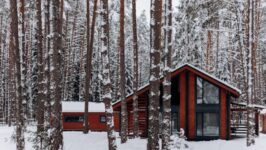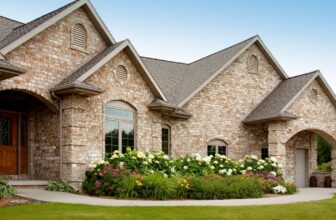
Is Alternative Log Cabin Siding Right for Your New Home

Homebuyers designing a new construction house can choose from different materials such as stone, stucco, wood and on. Those desiring a log house, however, were at one point given wooden logs as their only choice.
That’s changing – quality and qualified expert builders have started to use concrete designs to look like “logs.” If you’re considering this relatively new concept, you can get a free siding sample sent to you; it’s incredible how realistic the material is.
Vast benefits make a concrete house well worth the investment. It’s highly durable, offers increased comfort, reduces outdoor noise and safety, and is energy efficient. The concrete log-sided home is aesthetically appealing, with the option of customizing the design to suit home buyer preferences and needs.
The alternative for log-sided homes is quickly becoming favored in the home construction market as an option with few downsides. Let’s explore the many benefits you can expect when siding your new home with concrete logs.
Benefits Of Concrete for Siding a Log House
Concrete isn’t a material most people would associate with log cabins. These homes are commonly constructed of wooden logs and are appreciated for their stunning beauty.
Builders can now replicate that appeal using concrete, a more cost- and energy-efficient choice with an extended lifespan. The alternative to some is non-conventional; however, it’s increasingly popular with a range of benefits and few downsides.
Here, we’ll explore the many advantages associated with building a log-sided home constructed of concrete.
The Durability
Its high durability is among the greatest advantages of concrete material for a house. Homebuyers want a home that can tolerate all the abuses the outdoors brings, such as natural disasters.
Concrete outlasts other materials like steel and wood frames. These houses can stand for decades and beyond. Visit Can Concrete Log Siding Replace Wood Log Siding – to compare concrete and wood siding for log cabins.
Heightened Safety
Concrete offers superior protection against debris, fire, and strong wind gusts generally associated with hurricanes, tornadoes, and other natural disasters. The “National Fire Protection Association” notes the prevalence of house fires, roughly “one every 23 seconds.”
Concrete is fire-resistant and can protect homes; with a slow spread of flames, homeowners are given the chance to evacuate, and the house sees minimal damage. It can tolerate high heat with degradation of strength occurring gradually, slower than most other materials.
You can expect a concrete-constructed house to stand after fire and other natural disasters.
Wood and other materials could see extensive damage with a need for extensive restoration or a total rebuild. In a concrete-sided house, occupants may see damage to personal effects such as furnishings when experiencing a peril.
Extended Longevity
Concrete’s non-biodegradable qualities eliminate a susceptibility to deterioration or rot. Homeowners have concerns regarding wood rot and pest infestation with a wooden-log house.
The material can last decades and beyond, minimally 50 years. Prospective homeowners have the peace of mind of knowing not only that the house will withstand outdoor abuses but that they will consume much less energy. This can mean exceptional cost savings.
Energy Efficiency
As a homeowner, you can expect savings in utility costs when building a home using concrete. With this material, homeowners will consume less energy due to its strength, solid construction, and incredible insulation. Airtight insulation can mean using a heating and cooling system less.

The house will stay cooler in the summer and warm during the cold months. Air filtration can be reduced by as much as 70+ percent compared to a wooden-log cabin. Cold drafts are avoided, and you can anticipate a more climate-controlled household. Consider the following:
-
Thermal Resistance
R-value or thermal resistance measures heat flow resistance. The most effective insulation will have a higher R-value. When walls are airtight, as with concrete, occupants can anticipate saving tons of carbon dioxide than a wooden-framed house.
-
Eco-consciousness
A concrete-built residence will label you as environmentally friendly and reduce your carbon footprint. More emphasis is placed on these initiatives; in order to be designated as a “green” home, the house must conserve natural resources and perform optimally while consuming water and energy.
Concrete is healthier for the occupants and the environment overall. The material gets much from energy, reducing homeowners’ exposure to hazards such as mildew and mold. By using recycled materials, you save natural resources and decrease waste.
Concrete was first introduced following the Second World War in Europe. It is being used in Canada and other areas throughout North America. Governments, particularly in Canada, are encouraging the focus on energy efficiency with newly constructed homes, emphasizing the importance of conserving resources.
Initiatives from the government are leading to growth in the concrete housing market, which continues to increase throughout Canada and the US. Prospective homebuyers can expect a range of options in this industry in the future.
-
Cost Savings
A concrete house uses less energy than other materials, allowing reassurance for reduced consumption and giving homeowners the benefit of savings in utility costs.
Not only does the material allow money savings, but you can anticipate a reduction in heating and cooling usage thanks to the thermal mass material, helping maintain an even climate control. This can mean installing smaller HVAC systems to reduce costs with the build.
While the upfront investment could be higher for concrete “logs,” the overall energy efficiency and higher durability compared to wooden logs justifies the investment.
Safety and Comfortability
Concrete-constructed houses are heat-flow resistant, providing superior insulation compared to other materials.
This will mean maintaining better climate control and comfortable temperatures from one season to the next without constant temperature adjustments for the HVAC system, keeping it from overworking and consuming considerable energy.
Homeowners can enjoy a more tranquil household since concrete-built houses reduce outdoor noise levels. The walls absorb Sound-wave energy, reflecting it toward the source.
Because minimal sound energy penetrates concrete, the home’s interior remains quiet, free from traffic sounds or a noisy neighborhood, giving you a more relaxing environment. The sound insulation is highly beneficial for anyone who works late shifts or remote employees working from home.
Cost Efficiency
The upfront investment is typically higher for a concrete-sided house because of its durability, keeping the home standing when natural disasters strike. This will save much money from frequent repairs and extensive maintenance, as is true with a wooden-logged house.

Wood rot can compromise a traditional log home’s integrity. It’s susceptible to deterioration or degrading wood, pest infestations, and the possibility of mildew and mold. Wood rot is a nonissue for concrete, as is the possibility of pest infestations, which can lead to thousands of dollars to eradicate.
The energy conservation is also superior to other materials, saving considerably on utility costs and preserving HVAC equipment – you can potentially equip the house with a smaller unit, saving even more on costs with the build. Insurance carriers are more generous with policy premiums for efficient, sound properties.
While the construction costs can range roughly 5 percent higher than traditional builds, homeowners will realize considerable advantages not only in monetary savings but also with a more structurally sound, climate-controlled, quiet house and one boasting of reducing an owner’s carbon footprint.
That’s vital for those who prefer an eco-conscious lifestyle and want to work with builders and other businesses that follow environmentally friendly practices.
Final Thought
Construction of a concrete-sided log home with proper surface prep requires a specific knowledge and skill set not all contractors possess and sufficient resources available only for some builders.
A qualified and quality expert in concrete-constructed log cabins will build a sound, solid, and energy-efficient house that can save you money in numerous ways.
Click for details on the realistic appearance of wood-look design concrete siding. It’s the ideal home to protect a family, conserve natural resources, save costs, and perform efficiently for an extended lifespan.




